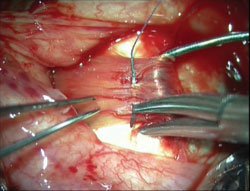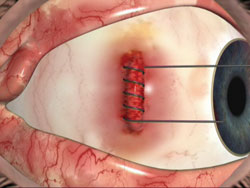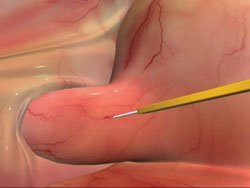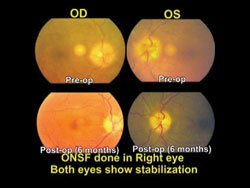Meticulous technique needed for optic nerve sheath fenestration
The surgery can be used in idiopathic intracranial hypertension to stabilize or improve the condition.
 Amar Agarwal |
Optic nerve sheath fenestration has been shown to be safe and effective in treating visual loss secondary to idiopathic intracranial hypertension.
Idiopathic intracranial hypertension usually affects young obese women. The most common features of benign intracranial hypertension include headache, transient visual obscurations, tinnitus, field loss and diplopia. There are many signs of papilledema, including disc hyperemia, dilated capillaries, blurring of disc margins, swollen discs, peripapillary nerve fiber layer hemorrhages, absent venous pulsations, engorged veins, hard exudates, hemorrhages and optic atrophy. All patients with papilledema need to be closely monitored for best corrected visual acuity, color vision testing, visual fields and fundus examination. The major goal of treatment is to prevent visual loss. Weight loss, a low-salt diet, and stoppage or avoidance of predisposing medications are options in early cases. Acetazolamide and steroids may also be used. Indications for surgery include progressive visual loss despite maximum medical treatment, severe visual loss, afferent pupillary defect and severe papilledema. Optic nerve sheath fenestration is highly effective and safe in cases unresponsive to maximal medical therapy.
Optic nerve sheath fenestration
Optic nerve sheath fenestration was first proposed by de Wecker in 1872. It involves cutting a window into the dura and arachnoid of the edematous optic nerve. This decreases edema on the ipsilateral side and sometimes in the contralateral side as well. It is more effective in acute papilledema than in chronic papilledema. It can also result in an improvement in headache. It is thought that the cerebrospinal fluid (CSF) leaking out through the fistula allows a decrease in CSF pressure and an improvement in peripapillary blood supply. An alternative hypothesis states that postoperative scarring and obliteration of the subarachnoid space might cause a shift in the pressure gradient, thus protecting the optic nerve head.
Surgical technique
Surgery is intricate and demanding. A medial orbital approach is preferred. Advantages include quicker access and lack of skin incisions. A 270· conjunctival peritomy is done, extending superiorly, medially and inferiorly. Blunt dissection is done under Tenon’s capsule. The medial rectus is then hooked and separated, and the muscle is imbricated at about 3 mm using a double-armed 6-0 polyglactin suture (Figure 1). This is done in a double whip-lock fashion, and the technique used is as for squint surgery. Both needles at either end of the double-armed suture are not cut as they are used again later for reattaching the muscle.
The medial rectus muscle is cut, leaving a stump of muscle tissue. A baseball traction suture is then passed through the cut stump from posterior to anterior, including a partial thickness bite of the sclera anterior to the muscle insertion. These sutures are used for retracting the globe laterally to enhance visualization (Figure 2). The long ciliary bundle is identified as the landmark. The superior and inferior rectus muscles are also isolated, and traction sutures are passed. The traction sutures on the medial, superior and inferior recti are then used together to pull the globe out of the orbit and laterally. A malleable retractor is inserted into the space between the disinserted medial rectus and the globe. The intrascleral course of the long ciliary nerve is then followed posteriorly toward the optic nerve.
 Figure 1. Medial recti secured. |
 Figure 2. Medial recti cut and rotated to expose the optic nerve. |
 Figure 3. Cut made into the dura of the optic nerve until a gush of CSF occurs. |
 Figure 4. Fundus picture preop and postop of a case in which optic nerve sheath fenestration was performed. Images: Agarwal A |
Long cotton-tipped applicators are used to sweep aside orbital fat prolapsing into the field. The delicate vortex veins and other vital neurovascular structures are avoided by careful dissection and maintaining anatomical landmarks. After every 60 seconds of dissection, all instruments are removed from the orbit, and traction on the globe is released for 1 to 2 minutes to allow perfusion to the central retinal artery and other intraocular structures. With more posterior dissection, the optic nerve becomes visible. The short posterior ciliary vessels and nerves are gently swept aside, taking care not to damage them. If there is any resistance, another avascular portion of the optic nerve is selected for fenestration. If dilatation of the lateral half of the pupil is noted at any point, all traction should be released and instruments removed. IOP is frequently checked digitally to ensure that acute angle-closure glaucoma is not present.
Two cotton-tipped applicators are used to tether the optic nerve into position. The central retinal artery enters the optic nerve at the inferomedial position; hence, all handling should be delicate. An MVR blade is passed, and a vascular portion of the optic nerve dura is cut longitudinally for about 2 mm, until an egress of CSF is seen (Figure 3). A nerve hook is then passed into the cut and rotated superiorly and inferiorly until all subarachnoid adhesions are lysed. The cut is then lengthened for about 4 to 6 mm. More posterior fenestration and sweeping should be avoided to avoid the central retinal artery.
Two additional fenestrations are made parallel to the first cut, and the subarachnoid space under each cut is joined by sweeping with the nerve hook. The first fenestration may release a gush of CSF that may not be as visible with subsequent fenestrations. Once the fenestrations are complete, it is ensured that there is no bleeding. The stump of the medial rectus is freed, and the muscle is reattached to the stump using the two needles that were attached to the muscle belly. Continuous sutures may be used. It should be ensured that the muscle is intact and not twisted. The superior and inferior recti are also released. The conjunctiva is then closed with sutures. The optic disc and retina are visualized at the end of surgery to ensure adequate perfusion, and the eye is then closed.
Most common complications include transient lateral rectus palsy, pupillary dilatation resulting from sphincter denervation and, rarely, transient or prolonged visual loss. Other complications include central retinal artery occlusion, orbital hemorrhage, permanent diplopia and angle closure glaucoma. Optic nerve sheath fenestration may be utilized for patients with idiopathic intracranial hypertension who refuse or cannot undergo a lumboperitoneal shunt.
Conclusion
Optic nerve sheath fenestration surgery has to be meticulous and the surgeon has to be careful, but when done properly, the results can be gratifying in improving or stabilizing the condition, not just in the ipsilateral side but also sometimes in the contralateral eye (Figure 4).

- Amar Agarwal, MS, FRCS, FRCOphth, is director of Dr. Agarwal’s Eye Hospital and Eye Research Centre. Prof. Agarwal is the author of several books published by SLACK Incorporated, publisher of Ocular Surgery News, including Phaco Nightmares: Conquering Cataract Catastrophes, Bimanual Phaco: Mastering the Phakonit/MICS Technique, Dry Eye: A Practical Guide to Ocular Surface Disorders and Stem Cell Surgery and Presbyopia: A Surgical Textbook. He can be reached at 19 Cathedral Road, Chennai 600 086, India; fax: 91-44-28115871; email: dragarwal@vsnl.com; website: www.dragarwal.com.
- Disclosure: No products or companies are mentioned that would require financial disclosure.
